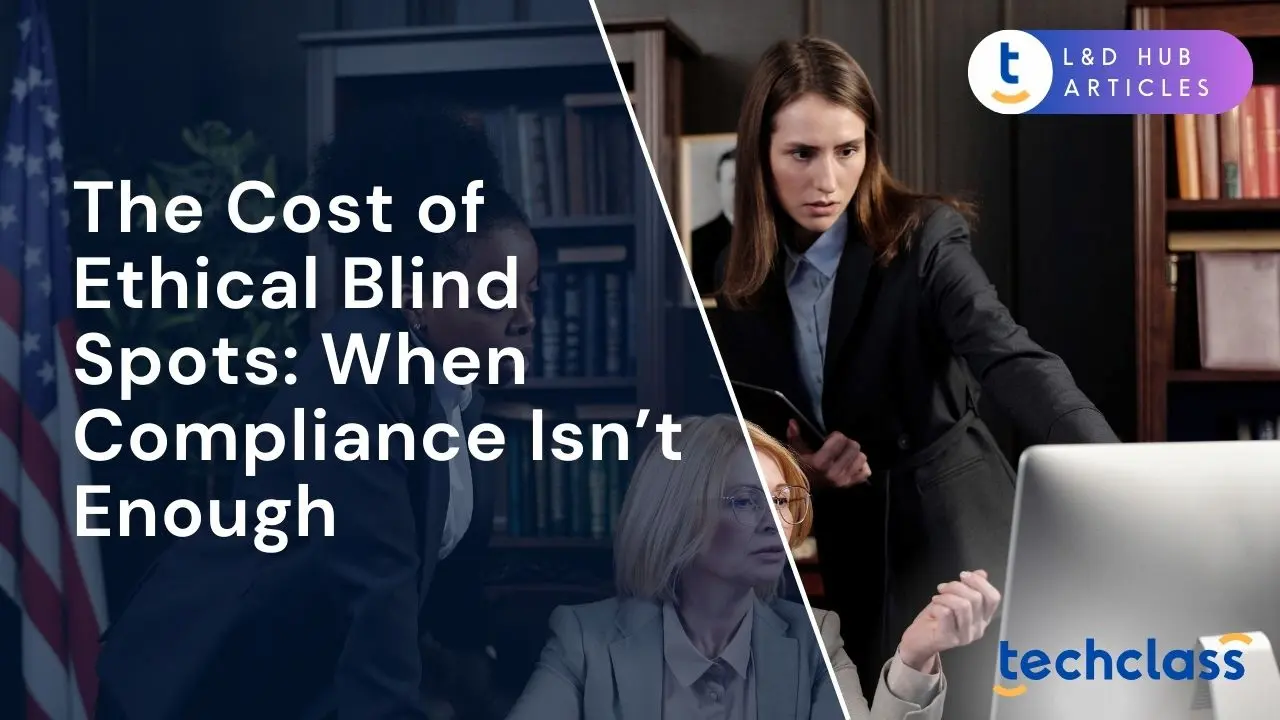
Imagine a company that prides itself on obeying every rule and regulation, yet still finds itself embroiled in scandal. Many organizations hit all their compliance checkmarks, policies written, annual trainings completed, audits passed, only to discover unethical practices festering unnoticed. The gap between doing what’s legally required and doing what’s right often stems from ethical blind spots. These blind spots are the unseen gaps in judgment and culture that let good people engage in or overlook bad behavior without realizing it. When leaders and employees fail to see the ethical implications of their actions, compliance alone isn’t enough to prevent trouble. The result can be hefty fines, damaged reputations, lost trust, and internal turmoil, costs that far outweigh any short-term gains from “doing business as usual.” In today’s business environment, simply following the rules is a starting point, not the finish line, for integrity.
In this article, we’ll explore what ethical blind spots are, why sticking to compliance checklists isn’t sufficient, and how such blind spots can silently erode an organization’s success. We’ll also discuss real examples of compliance failures and outline strategies to foster an ethical culture that fills in those blind spots. The goal is to help HR professionals, business owners, and enterprise leaders recognize the hidden ethical risks in their organizations, and address them before they become costly crises.
Ethical blind spots refer to the areas where people’s own biases or situational pressures prevent them from seeing the unethical nature of their decisions. Research in behavioral ethics has shown that “good people do bad things without being aware that they are doing anything wrong”. In other words, even well-intentioned employees and leaders can have gaps in their ethical awareness. These gaps might include unconscious biases (for example, gender or racial biases one doesn’t realize they have), conflicts of interest that subtly sway decision-making, or the tendency to overvalue in-group loyalty. All these factors can lead individuals to act against their own stated values while sincerely believing they are doing the right thing.
One common blind spot is motivational blindness, the phenomenon where people ignore unethical actions of others when noticing would harm their own interests. Classic examples include auditors overlooking a client’s dubious accounting because flagging it could cost them the account. In a high-pressure sales environment, a manager might look the other way on aggressive tactics if those tactics boost their team’s numbers. Over time, such blind spots create an “ethical fading” effect, where the moral dimensions of a decision become obscured by business-as-usual thinking or the drive to meet targets.
Notably, traditional ethics programs and Compliance Training initiatives often focus on preventing intentional misconduct (e.g. “don’t bribe officials” or “don’t steal data”). Yet many ethical failures are unintentional — people rationalize their behavior or simply fail to see the harm in it. If corporate ethics programs give limited attention to this bounded ethicality, the systematic ways normal people err ethically, they leave a critical gap in prevention. In short, ethical blind spots are those hidden hazards in our decision-making processes and corporate cultures. They lurk in the background of policies and procedures, and if we don’t shine a light on them, we can’t fix what we don’t see.
Organizations often equate having a compliance program with being “ethical.” Compliance is certainly essential, it means obeying laws, regulations, and company policies. However, compliance by itself is the floor, not the ceiling, of ethical behavior. Just because something is legal or allowed on paper doesn’t automatically make it right. Companies that focus only on ticking the compliance boxes may develop a false sense of security. In reality, a “surface-level approach” to ethics, where rules are in place but day-to-day culture remains unchanged, can leave serious ethical blind spots.
Too often, compliance is treated as a checkbox exercise: policies are drafted, one-off trainings are held, audits are conducted, and everyone assumes the organization is covered. Yet if employees are just going through the motions, underlying attitudes and behaviors might not align with the company’s stated values. For example, an organization might have an anti-harassment policy (compliance) but still foster a culture where complaints are discouraged or ignored (ethical lapse). A company might ban bribery officially, but reward a “win at all costs” sales mentality that implicitly encourages cutting corners. In such cases, people may technically follow the rules while ethically “coloring outside the lines.”
The key difference is that compliance asks, “What can we do within the rules?” whereas ethics asks, “What should we do to uphold our values and responsibilities?”. A purely compliance-focused mindset might prompt employees to seek loopholes or take advantage of gray areas, as long as there’s no explicit rule against an action. An ethical mindset, by contrast, encourages employees to consider the broader impact of their choices on stakeholders, coworkers, customers, society, even when the law is silent on the issue. In other words, compliance is about meeting the minimum standards, while ethics is about aspiring to the highest standards.
When companies rely on compliance alone, they risk creating a culture of “legalism” without moral reflection. Employees might feel that if it’s not expressly forbidden, then it must be okay, a mentality that opens the door for ethical blind spots to flourish. As one HR leadership article put it, “Compliance should be seen as the floor — the minimum threshold — while ethics define the ceiling.” In practice, this means that leadership must promote values like honesty, fairness, and respect beyond what regulations demand. Otherwise, an organization can outwardly have a clean record yet still accumulate ethical missteps that eventually snowball into a crisis.
Ethical blind spots aren’t just philosophical concerns, they carry very real costs for businesses. When individuals or teams slip into unethical behavior unnoticed, the organization as a whole pays the price sooner or later. These costs can be financial, legal, and reputational, and they often far exceed any short-term benefit gained from the unethical acts. As an example, consider the insight from a MIT Sloan Management Review analysis: the “consequences of failing” to act ethically tend to be much more harmful to the bottom line than many leaders realize. Companies may reap a quick gain by bending the rules or ignoring a minor ethical lapse, but that misconduct can set off a chain of outcomes, from lawsuits to customer exodus, that easily outweigh those short-term gains.
Financial and Legal Costs: Perhaps the most direct costs come in the form of fines, penalties, and legal settlements. History is rife with cases where a blind spot in ethics proved ruinously expensive. For instance, Volkswagen’s infamous “Dieselgate” emissions cheating scandal was initially an attempt to meet performance goals on paper. In the end, it exploded into one of the costliest corporate scandals ever, over €31 billion (≈ $35 billion) in fines and settlements according to Reuters. Similarly, at Wells Fargo, unchecked sales pressure led thousands of employees to open fake customer accounts to hit targets. The bank had compliance policies, but its sales culture created an ethical blind spot. The result? Wells Fargo was fined $185 million for these practices, and roughly 5,300 employees were fired once the truth came out. These are stark reminders that ignoring ethical red flags can lead to massive financial losses and legal repercussions that far eclipse any perceived “benefit” from the unethical behavior.
It’s not only large-scale scandals; everyday occupational fraud and misconduct add up as well. The Association of Certified Fraud Examiners (ACFE) estimates that organizations worldwide lose about 5% of their annual revenue to fraud, which translates to an astounding $4.7 trillion globally lost to occupational fraud each year. Each instance of unethical behavior, from expense report fraud to intellectual property theft, chips away at profits. In effect, ethical blind spots act like a hidden tax on business performance.
Reputational and Trust Costs: Beyond direct monetary losses, ethical missteps inflict deep damage on a company’s reputation and stakeholder trust. Trust, once broken, is difficult and expensive to rebuild. A publicized ethics scandal can drive away customers, scare off investors, and demoralize employees. As one business leader famously said, “It takes years to build a good business reputation, but one false move can destroy it overnight.” A company viewed as deceitful or irresponsible may face consumer boycotts and find that top talent is unwilling to work for them. In Wells Fargo’s case, the bank’s decades-long reputation of trust was severely tarnished; customer accounts and loyalty plummeted when the fake accounts scandal came to light. Volkswagen not only paid fines but also saw sales dip and faced an uphill battle to regain public confidence in its brand.
Studies consistently show that ethics matter to stakeholders. In one survey, a majority of consumers said they base purchase decisions on a company’s ethics and would even pay a premium to support ethical brands. Investors, too, are increasingly factoring environmental, social, and governance (ESG) criteria into decisions, a company with ethical blind spots risks being shunned by values-driven investment funds. Internally, unethical practices corrode workplace culture. Employees who see wrongdoing go unaddressed often disengage or exit, leading to higher turnover and lower productivity. Low ethical standards from management can breed cynicism, conflict, and lack of teamwork among staff. On the flip side, organizations with a strong ethical culture enjoy benefits like higher employee morale and loyalty, better customer satisfaction, and even superior financial performance over the long run.
In summary, the cost of ethical blind spots can be measured in dollars and cents, but also in broken trust, lost opportunities, and human capital. Companies that suffer ethical failures may face government sanctions and lawsuits, but the less visible costs, a poisoned brand image, skeptical consumers, and a demotivated workforce, can linger for years. By contrast, companies that invest in ethical practices often find that “ethics pays” in the form of resilience and sustained success. Preventing ethical blind spots isn’t just a moral issue; it’s a business imperative to avoid the slippery slope of dishonesty that leads to “ruinous fiscal outcomes”.
Closing ethical blind spots requires proactive effort at both the organizational and individual level. Here are several strategies enterprise leaders and HR professionals can use to illuminate and eliminate these blind spots:
By implementing these strategies, companies can greatly reduce their ethical blind spots. The overall aim is to embed ethics into the fabric of the organization, making it not just a matter of formal compliance, but a shared mindset. When ethical considerations become an integral part of everyday decision-making, blind spots are more likely to be spotted and addressed in time. Over the long run, this kind of ethical culture is a competitive advantage: it safeguards the firm’s reputation, keeps employees engaged and proud, and builds trust with customers and partners.
In the final analysis, “compliance isn’t enough” because rules alone cannot foresee every moral challenge or eliminate every bias. Laws and policies set important minimum standards, but true integrity in business requires going beyond what’s required, toward what’s right. Ethical blind spots will always exist to some degree, we are all human, prone to bias and error, but their impact can be minimized in an organization that values reflection, transparency, and accountability. For HR professionals and enterprise leaders, the charge is clear: make ethics an everyday conversation, not just an annual checkbox.
Leading beyond compliance means cultivating a kind of ethical eyesight at all levels of the company. It means encouraging employees to pause and consider the ethical fallout of decisions, empowering them to speak up, and rewarding them for doing the right thing even when no one’s watching (or when it costs the company in the short term). It means leadership that asks not just “Did we meet the target?” but also “Did we do it the right way?” and “What did we learn about our values from this outcome?”. By conscientiously addressing ethical blind spots, organizations protect themselves from the costly scandals that make headlines, and more importantly, they build workplaces characterized by trust, fairness, and respect.
For any business, in any industry, reputation and culture are invaluable assets. When compliance is paired with a strong ethical compass, those assets are protected. Employees know they won’t be pressured to compromise their principles. Customers and partners know they can rely on the company’s word. And leaders can sleep at night knowing that they are not just obeying the rules, but honoring the spirit behind them. In the end, the cost of ethical blind spots, in money, relationships, and opportunities lost, is a price no ambitious organization can afford to pay. The better path is clear: shine light on those blind spots, invest in ethics, and lead with integrity beyond the bare minimum of compliance. Your people, and your bottom line, depend on it.
Ethical blind spots are gaps in awareness that prevent individuals from recognizing the ethical consequences of their actions. They often result from unconscious biases, conflicts of interest, or situational pressures, leading people to act against their own values without realizing it.
Compliance ensures that organizations follow rules and laws, but it doesn’t cover every ethical dilemma. Employees may technically obey regulations while overlooking harmful behaviors. True ethics require asking not just “Can we?” but “Should we?” to uphold integrity.
The costs include financial penalties, lawsuits, reputational damage, loss of customer trust, and employee disengagement. For example, scandals at Wells Fargo and Volkswagen show how blind spots can lead to billions in fines and lasting reputational harm.
Organizations can reduce blind spots by modeling ethical leadership, aligning incentives with values, offering scenario-based training, creating a speak-up culture, and encouraging reflection on real-world dilemmas. Building ethics into everyday decision-making helps close these gaps.
Leaders set the tone for organizational culture. When leaders prioritize integrity and reward ethical choices, employees are more likely to follow. Leadership that openly discusses ethics and takes responsibility for mistakes helps prevent blind spots from festering.


